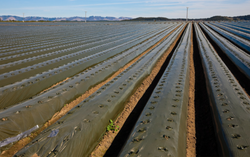New Codes for Plastic found in Cotton Samples
Plastic contamination in US-grown cotton is a significant issue throughout the supply chain, and the USDA has taken an initial step aimed at addressing this problem. The agency is implementing a new pair of extraneous matter codes for levels of plastic contaminants found in cotton samples. The USDA’s AMS Cotton and Tobacco Program is now enforcing codes 71 and 72 (as of July 1) as identifiers of plastic contamination, in line with other codes for seed (coat fragments), bark, grass, oil, and other materials.
The world has long accepted the US cotton industry as the leading producer of quality cotton. In recent years, however, with the introduction of the John Deere round module and accompanying plastic cover, farmers and ginners were left to develop their own method for removing the cover. More often than not, they left the plastic cover in with the harvested cotton unintentionally. To be fair, Deere developed the new module to reduce the labor costs involved with the old rectangular modules, and this innovation proved to be a winner for the harvesting and collection of cotton. Still, the new covers presented problems farther down the supply chain.
Another source of plastic contamination occurs when farmers grow crops that require black plastic ground cover and later plant cotton after tilling the black plastic under the soil. When the cotton plant grows, the black plastic that has been tilled under emerges with the plant and is then harvested along with the cotton. Also, module trucks may pick up any black plastic on the ground when transporting the module, round or rectangular, to the gin.
As consumers worldwide are demanding more natural products for personal hygiene and baby products, these plastic contaminants are a significant detractor for sales and brand perceptions. Purified Cotton is replacing synthetic fibers that are white and largely without contamination, so consumers are trained to expect perfectly clean substrates in their hygiene products. Yellow, pink, blue, or black plastic contamination is not acceptable for these products and the US Cotton Industry must find a way to totally eliminate it.
The National Cotton Council and other industry associations have led awareness campaigns and educational series to address these issues with farmers and ginners to help reduce the problem of plastic contamination in cotton. These new codes recently introduced by the USDA are important step towards penalizing those who are cutting corners, failing to take the necessary precautions that assure the high-quality cotton expected from the US Cotton industry for decades.
For more information on this issue, visit this link from the USDA.
